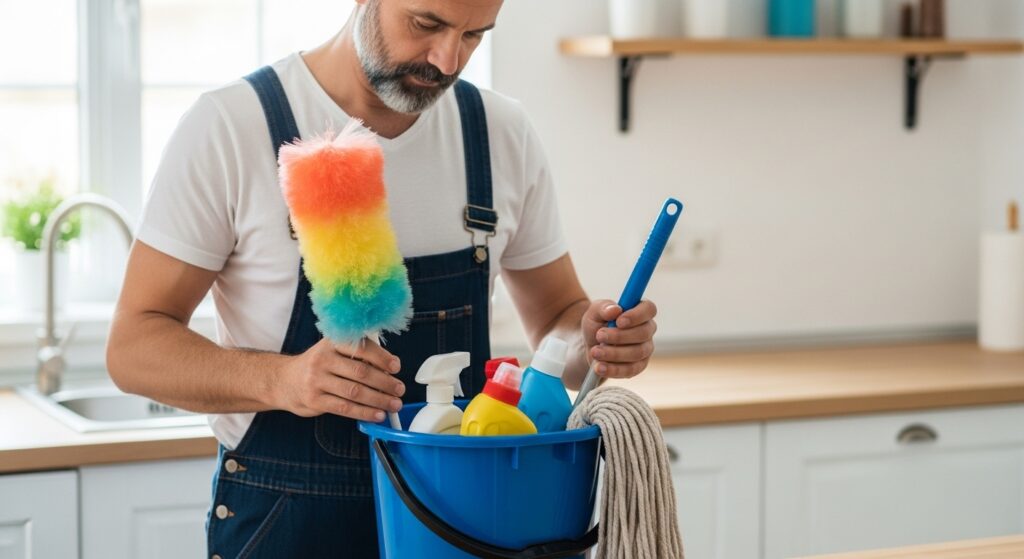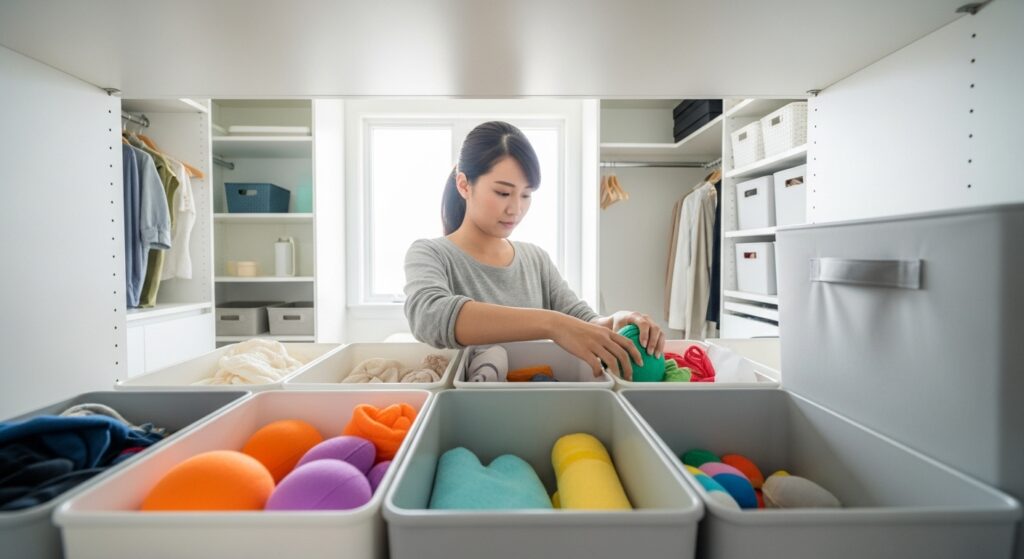Introduction: Why Deep Cleaning Truly Matters
Deep cleaning is different from regular cleaning because it targets the hidden dirt, grime, and buildup that everyday tidying misses. It goes beyond surface-level chores to thoroughly sanitize and refresh every nook and cranny of your home. This kind of cleaning brings benefits that you can actually see and feel—your space will look brighter, smell fresher, and feel healthier.
Taking on a thorough deep clean can feel overwhelming, but breaking the task down makes it doable. This guide will help you tackle every area efficiently by giving you clear steps and tips, so you can regain control of your home without stress or confusion.
1. Start with Decluttering
Before diving into deep cleaning, it’s important to remove clutter first. Clearing out unnecessary items not only frees up space but also makes cleaning much easier and faster. Use the simple sorting method: create piles for Keep, Donate, and Trash so you can decide what stays and what goes.
Decluttering has a big impact on your cleaning progress. It clears visual distractions and helps you focus on the actual cleaning tasks ahead. Plus, letting go of unused things can give you a sense of accomplishment that motivates you to keep going.

2. Gather Your Cleaning Supplies
Having the right cleaning tools and supplies is key to an effective deep clean. Make sure you have essentials like microfiber cloths, scrub brushes, mops, vacuum cleaners, and trash bags ready before you start. This preparation saves time and keeps you focused.
Choose cleaning solutions that work best for different surfaces in your home. Eco-friendly products can be just as powerful and are better for your health and the environment. Using the right cleaners helps protect your surfaces and ensures a thorough, safe clean every time.

3. Deep Cleaning Room-by-Room Checklist
a. Kitchen
Start by thoroughly cleaning your countertops, appliances, and sinks. Pay special attention to hidden spots like behind the fridge or under the stove. Deep clean the fridge, oven, and microwave by removing all food, wiping surfaces, and tackling any stubborn stains. Don’t forget to clean out your cabinets and pantry, discarding expired items and wiping down shelves. Finally, sweep and mop the floors, and empty trash areas to leave your kitchen spotless.
b. Bathrooms
In the bathroom, scrub showers, tubs, toilets, and sinks carefully. Focus on removing mildew and cleaning grout to prevent buildup. Wash or replace shower curtains, mats, and towels regularly to keep things fresh. Disinfect all high-touch surfaces like faucets, light switches, and doorknobs to maintain hygiene and a clean smell throughout the space.
c. Bedrooms
Dust all furniture and fixtures, including nightstands, dressers, and shelves. Wash your bedding and curtains regularly, and air out mattresses to keep the room fresh. Organize and declutter closets, donating clothes you no longer wear. Clean the floors by vacuuming carpets and rugs or mopping hard surfaces to complete the bedroom refresh.
d. Living Areas
Dust your shelves, electronics, and decor carefully to remove all dust particles. Clean upholstery and carpets using a vacuum or steam cleaner to eliminate dirt and odors. Don’t forget to wash windows and take care of window treatments like blinds or curtains. Maintain the floors with regular sweeping, vacuuming, or mopping depending on the surface.
e. Garage, Yard & Outdoor Spaces
Sweep and power wash decks, patios, and porches to remove dirt and grime. Clean out your gutters to ensure proper drainage. Organize garage storage by sorting items and clearing clutter. For the yard, perform basic lawn care tasks like mowing, raking leaves, and tending the garden to keep outdoor spaces tidy.
f. Kid Areas and Playrooms
Sanitize toys and play surfaces to prevent germs from spreading. Organize books, crafts, and clothes to keep the space functional. Wash soft toys and fabrics regularly to maintain cleanliness and freshness for your little ones.
g. Pet Areas
Clean pet beds and toys often to keep odors and bacteria away. Remove hair and dander with a vacuum or specialized tools. Neutralize pet odors using baking soda or fabric sprays. Maintain litter boxes and feeding areas by cleaning them daily for your pet’s health and your comfort.

4. Extra Deep Cleaning Tips
Don’t forget to clean often-overlooked areas like walls, baseboards, and ceiling fans. These spots tend to collect dust and grime, making your home feel less fresh. Clean light fixtures and vents regularly to improve air quality and lighting. It’s also important to maintain appliances and fixtures by wiping them down and checking for any repairs or deep cleaning needs. Remember to schedule and pace your deep cleaning so you don’t get overwhelmed—breaking the work into manageable chunks keeps it doable and efficient.
5. How to Maintain Your Clean Home
Keeping your home clean after a deep clean is easier with daily and weekly habits. Create a simple cleaning routine that includes quick daily tasks and more thorough weekly ones. Get your family involved by assigning small chores, making cleaning a shared responsibility. Prevent clutter by tidying up regularly and putting things back in their place. Plan to schedule a deep cleaning session every few months to refresh your home and keep it in great shape long term.

6. Optional: Storage Solutions During Deep Cleaning
Using portable storage units can be a game-changer when deep cleaning, especially if you need extra space to declutter and organize. These units give you a temporary home for items you don’t need right now, making it easier to focus on cleaning without distractions. If you’re tackling a big project, renting storage can help keep your home clutter-free while you sort through belongings.
For large cleaning sessions, consider temporary storage solutions like boxes, bins, or storage containers to keep things organized and off the floor. This way, you can move through your home faster and more efficiently. Once your deep clean is done, gradually return items to their proper places or decide what to keep, donate, or discard. Temporary storage helps maintain momentum and reduces the stress of a messy house during cleaning.

Deep cleaning your home may seem like a big task, but with small, consistent steps, it becomes manageable and even rewarding. Remember, it’s not about perfection but progress—each deep clean brings you closer to a healthier, more peaceful living space. Stay patient, use the right tools, and don’t hesitate to ask for help when needed. Your home deserves the care, and you deserve the calm that comes with it. Keep going—you’ve got this!
FAQ´s
- How often should I deep clean my house?
Deep cleaning is recommended at least twice a year to keep your home thoroughly clean and fresh. However, if you have pets, allergies, or a busy household, you may want to deep clean more often. Regular maintenance cleaning in between helps reduce the need for frequent deep cleans. - What are the must-have supplies for deep cleaning?
Essential supplies include microfiber cloths, an all-purpose cleaner, disinfectant, scrub brushes, a vacuum with attachments, mop, trash bags, and gloves. Eco-friendly solutions like vinegar and baking soda are also effective and safe for many surfaces. - Can I deep clean my house alone, or should I get help?
You can deep clean on your own, but enlisting family or friends can make the process faster and less overwhelming. For very large or tough jobs, hiring professional cleaners is a smart option. - How do I stay motivated during a deep cleaning project?
Breaking the task into manageable steps, setting timers, playing music, and rewarding yourself after completing sections can help keep motivation high. Remember, small progress is still progress. - What areas should I prioritize when deep cleaning?
Focus on high-traffic and high-touch areas first, such as kitchens, bathrooms, and living rooms. Decluttering before cleaning makes the process easier and more efficient.
6. How can I maintain my home after a deep clean?
Create daily and weekly cleaning routines, involve family members in chores, and declutter regularly to prevent buildup. Consistency is key to keeping your home clean long-term.

